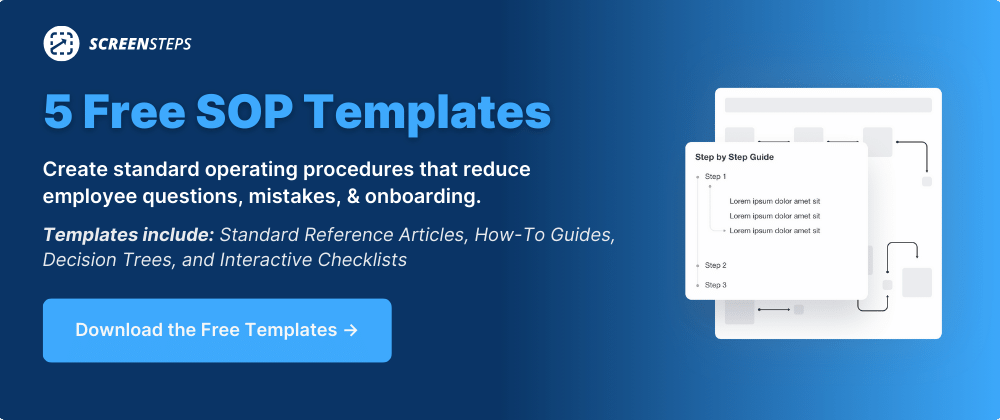Policy vs Process vs Procedure: What's the Difference? (+ Examples)
ARTICLE SUMMARY
You know you need written policies, processes, and procedures for your business, but how are the 3 Ps different? When do you use each of them?
I’ve been there. I asked the same question when I started working for ScreenSteps, a knowledge base software company that helps companies create, store, and share their policies, processes, and procedures.
What I learned, is that the 3 Ps tend to get used interchangeably in business — but each P represents a different aspect of sharing company information. They are all important and play a specific role in your company.
To provide some clarity on the 3 Ps, I’ll quickly define the roles of policies, processes, and procedures in your business. Plus, I provide an example of how each works. Then I explain why it helps to document all three for your company.
What is the difference between a policy, process, and procedure?
While policies, processes, and procedures are all used in companies to answer specific questions, their roles in answering questions are slightly different.
These three resources are also known as learning assets that help instruct your employees in classroom training or while in the workflow.
Watch this 3.5-minute video for a quick overview. Then keep reading for a more detailed explanation as well as some examples.
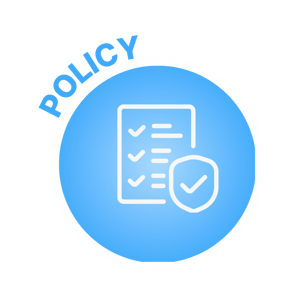 Policy
Policy
Policies are the rules and regulations of your company. They are the goals, values, and acceptable behaviors as determined by your company leadership team. These guidelines are used to ensure consistency and compliance throughout your organization.
It is a resource that tells employees the what, who, why, or when behind your business’s operations. Policies tell the employee what’s allowed and what’s not allowed as well as when it might be allowed. More specifically, a policy tells employees:
- What the policy is and its classification
- Who is responsible for completing and enforcing a policy
- Why a policy is required
- When a policy needs to be used and enforced
Instead of going into details, policies tend to be broad and general. This is because they are a core part of a company’s operations. Because of the broad nature of policies, they tend to change infrequently.
Examples of a policy
For banks, they have policies surrounding all of their transactions. If someone comes into a bank looking to refinance a loan, then the bank would have a policy that allows people to refinance on a loan if X conditions are met.
Another example is in retail. Most retail stores have a return policy that requires customers to return unwanted items within X amount of days. Those policies include the company’s stance on what to do if the item is returned after that time or if the item has been used.
In both of these examples, the policies cover the stance and conditions that are allowed.
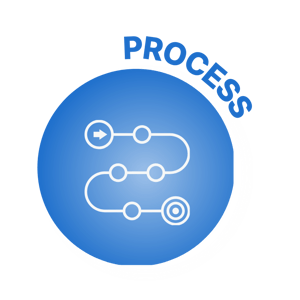 Processes
Processes
A process is a big-picture look at everything that needs to be done. It is a series of tasks (aka procedures) that lead to a result. Think of your processes as your roadmaps for what your employees need to do.
With a process, you know:
- Who is responsible for each part of the process
- What needs to be done (overview of complete task)
- In which specific order the tasks need to be completed
Note: There can be multiple procedures within one process. Often, processes cross multiple departments.
When you write your processes, you can link to the specific procedures to make it easier for your employees to find the next steps they need.
Examples of processes
For example, if your employee is working with a client to refinance their loan, there would be multiple steps to the process over time. The process would lay out the tasks (i.e. review credit score, check policy, review loan application, etc.) that must be done to refinance a loan.
With our retail example, the process would include everything that needs to be done before accepting the returned item. That includes checking the receipt, ensuring the return fits into the return policy, checking the item for use, etc.
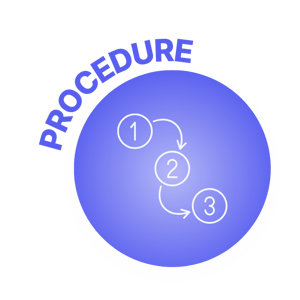 Procedures
Procedures
If the process is the big picture, the procedure is where you get into the details.
A procedure — also known as standard operating procedures (SOPs) — is the step-by-step instructions for each individual task.
Since your process is your roadmap, your procedures become the detailed instructions for how to turn the car on, how to put it into drive, how to change lanes, etc. These are the step-by-step instructions for how to execute the processes in your company.
Because SOPs are so granular, they are continuously changing and improving. You regularly need to update the procedures for new steps, clarifications, or new details.
SOPs address:
- How to perform a task in a specific system (e.g. CRM)
- How to adapt to specific variables (e.g. if the return is after 30 days, do this)
- What to say in certain situations
- What questions to ask
A procedure would take one specific step in the process and go into thorough details on how to complete that part. So essentially, here is how you perform task A in system X.
Examples of procedures
Continuing with the loan example, an employee would have a process for handling a loan that would list everything to check while reviewing the loan application. Confirm their credit score, update their timeline, determine if they have borrowed from the bank before, etc.
Then, the employee could check procedures for how to perform each task: Where to go in the system to confirm the credit score, which buttons to click when updating their timeline, how to determine whether they have borrowed money from the bank before, etc.
For the retail example, the procedures could detail what to ask the customer, how to handle a returned item, and which buttons to click to return the item.
🔍 Related: 6 Tips to Improve (& Shorten) Your Standard Operating Procedures
Why you need the 3 Ps for your business
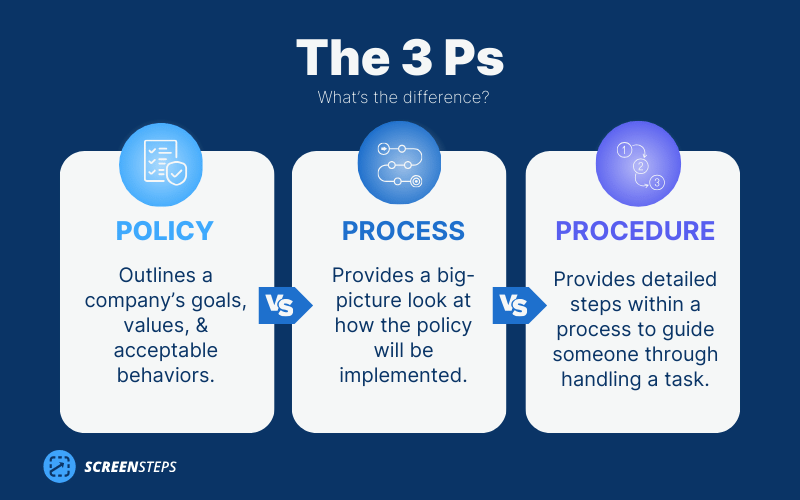
While it takes a lot of time and planning to document all of your policies, processes, and procedures, it is essential for organizing every business.
Policies, processes, and procedures work together to keep your company compliant and ensure consistency across the company.
When you have documented guides, you can delegate more tasks. Plus, it is easier for employees to cover for each other when someone is out sick.
As a small business, you may not need to document your policies, processes, and procedures yet. If you have less than 10 employees and everyone is an expert at the 3 Ps, you may be able to put off documenting your company information for now.
However, if you are planning to grow your business, then you’ll want a plan for documenting all your policies, processes, and procedures. It makes it easier for your company to scale because employees have resources to reference when they have questions.
How to write clear procedures your employees will use daily
Policies, processes, and procedures are all important resources that support your employees on the job. It’s important to understand which role each plays in teaching and aiding your employees. Together, they ensure compliance and consistency in your company.
There are many ways to document the 3 Ps, including different applications and software.
With the ScreenSteps knowledge base software, you have a one-stop shop for all of your policies, processes, and procedures. In ScreenSteps, you can quickly create articles for your 3 Ps and share them with your team.
The robust content creation tools help you clearly explain and show the steps in your policies, processes, and procedures. This helps employees avoid mistakes.
Want to document your procedures, but not sure how to start?
Whether you are documenting your first procedure or optimizing existing SOPs, this article helps you know how long your written procedures should be as well as what to include in your SOPs.
Download these free SOP templates to get started documenting your SOPs today.





